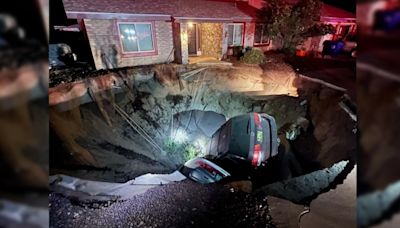Search results
Jun 9, 2018 · A sinkhole is an area of ground that has no natural external surface drainage--when it rains, the water stays inside the sinkhole and typically drains into the subsurface. Sinkholes can vary from a few feet to hundreds of acres and from less than 1 to more than 100 feet deep.
Sinkholes typically form when naturally acidic rainwater erodes underlying bedrock, creating damage beneath the surface. Their formation is most common in easily erodible karst terrains with...
Apr 8, 2024 · A sinkhole is basically a hole which appears to suddenly open up in the ground. However, the process that leads to a sinkhole is not so sudden and may have been developing over a long period.
Jan 9, 2016 · What is a sinkhole. They go by called many names (snake hole, swallow hole, or doline). They’re big, they appear seemingly out of nowhere, and they can “devour” houses in the blink of an eye.
6 days ago · sinkhole, topographic depression formed when underlying limestone bedrock is dissolved by groundwater. It is considered the most-fundamental structure of karst topography. Sinkholes vary greatly in area and depth and may be very large.
Most sinkholes occur in places where water can dissolve the rock below the surface, for example where the bedrock is limestone, salt, or gypsum. They can collapse very quickly, or slump slowly over time. Many sinkholes occur naturally, but human activities can also cause them.
Jun 26, 2017 · Sinkholes are pits in the ground that form in areas where water gathers without external drainage, according to the U.S. Geological Survey.



